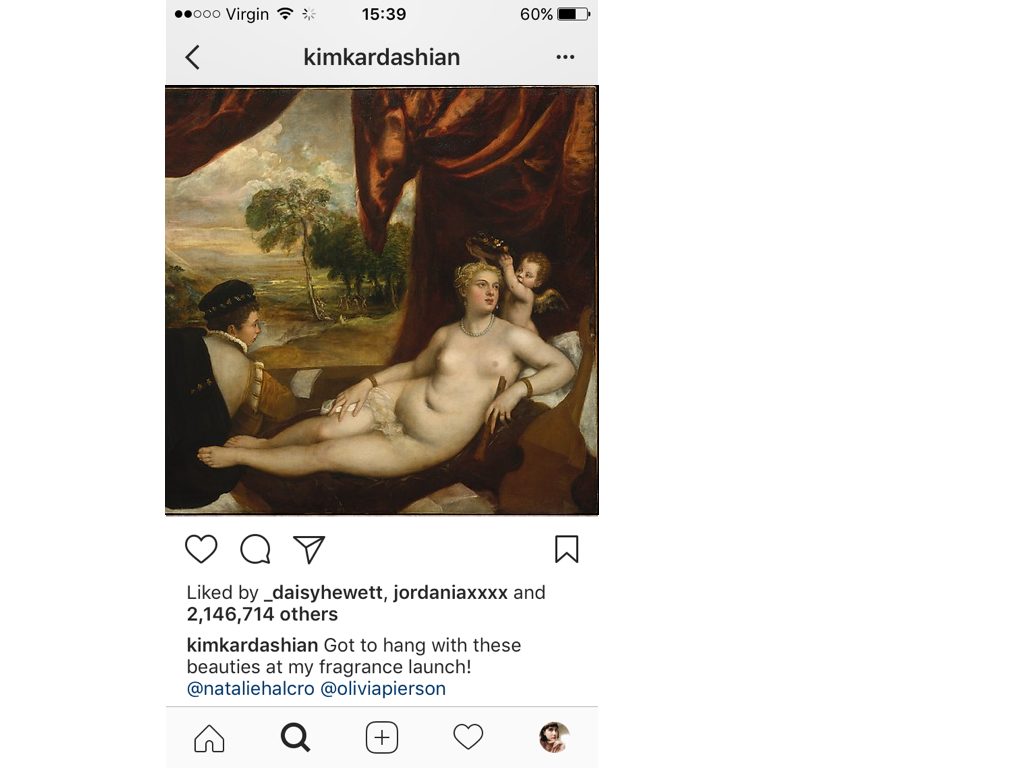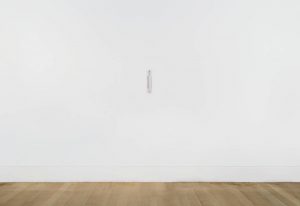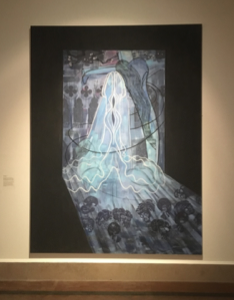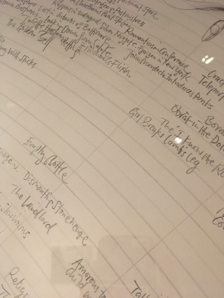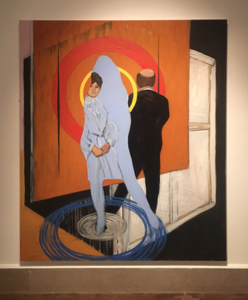Within this piece of work I took an old renaissance image created by Titian and made it into a modern day Instagram post; By doing this I am commenting on the way in which images are seen in the present day and what is classified as art. Using an original Instagram post by Kim Kardashian shows the levels of people that social media can effect in the same way that art would have previously done. The irony of the actual imagery used shows venus being pampered and entertained, and pairing this with the caption “Got to hang with these beauties at my fragrance launch!” almost insinuating that the character of venus would want to come across as being friendly with the people who were tending to her every need. Developing this imagery would be interesting as I could create an entire series comparing the modern day to the past and creating contemporary vs classic outcomes where the lines are blurred, in a similar vein to this outcome I would paint my own imagery in the style of renaissance paintings but still keep the modern figures and frame them within social media handles to contrast to the photographs that you would normally see in that setting.
Category Archives: Fine Art
Beth Ashford – Task 7
Richard Serra’s ideals on public art range from discussing the ideas of site specific work to how government controlled art should not be formed based purely on the idea of a piece of art being made for public consumption. Looking into the idea of church’s, specifically frescoes on the walls and ceilings, Serra discusses how the artwork distorts and detracts from the architecture of the building and removes the ideology of a ceiling being a ceiling; Referencing this to his own work the artist prefers to create a piece of art that compliments the architecture around it (making it site specific) without detracting from the surroundings.
In comparison Leo Steinberg looked closer at the idea of how the artwork changed over periods of time along with how a simplistic painting ended up being not the only way to position art, instead people such as Warhol and Lichtenstein produced printed works available to the masses. This different presentation of work also relates back to Richard Serra’s idea of public art as it is a way for a large variety of people to be exposed to different creations without interrupting the spaces surrounding them, this changes the relationship between the imagery and how the viewer interacts with it in different settings.
Task Twelve: Theories of Art
The Institutional Theory Of Art
The Institutional Theory Of Art is the theory that an object can be or become art in the context of the institution known as “the art world” – i.e. a gallery. For example Ceal Floyer’s ‘Monochrome Till Receipt (White)’ (1999) is simply a till print-out of a list of items purchased by Floyer at Morrison’s. However, despite the title the receipt is in fact has a yellowish- white tone and the information is printed in blue ink. Nevertheless, all the items are white or have the word ‘white’ in their name, for example; flour, hand cream, toothpaste, white chocolate, tissues and many more, in fact there are forty nine purchases in total. By the receipt being framed and in a gallery it creates a conceptual transformation, it immediately gives the art a deeper meaning. It makes people look at the object longer- for example, in this case, in order to realise all the items are white you would have to look at it longer, and defiantly longer than you would normally look at a receipt you found (unless it was your own).
The setting of a gallery (“art world”) can make people think about a completely mundane, everyday object in a much deeper, conceptual way and makes them view it as art due to the change in context and setting. This, therefore, is a prime example of an object becoming art by changing its environment and institutionalising it into the art world.
Task 6
An Artist’s practice refers to both the conceptual and making processes of an artwork or series of artworks. It examines how the artist develops ideas and themes through the influence of their society and fellow contemporaries.
One artist that particularly inspires me is Robert Smithson. His practice involves the concept of entropy and irreversibility through Land Art. Smithson, being the driving force behind the introduction of the movement, ‘reinvented the Stone-Age’ (Jones, 2015) through expressing his personal interests in Geology and Minerology. In one his most famous essays Entropy and The New Monuments (1969), Smithson’s core idea was that of the Law of Thermodynamics. A law that predicts the eventual exhaustion of any given system, be it a natural life cycle/ecosystem or a building. He spookily referred this theory as similar to our society, suggesting the eventual collapse of it, resulting in war and other social/political issues.
Much like Smithson, I would like to develop a practice that involves the subject of entropy, history. Land Art/sculpture holds some interest to me but I would like to look into irreversibility in terms of painting and drawing. Looking into the process and age-old traditions of paint and turning it on its head slightly, celebrating the spirit of the modern artist rituals. Perhaps taking Destructivist view on my work in a painting context. Gerhard Richter for example is a painter that looks at a similar theme to this within his practice, layering paint over paint, scraping away and re-painting. Making arguably unchangeable decisions constantly within a painting. Creating history and encapsulating time in a painting.
Jones, J. (2015) Robert Smithson: the epic life of an American enigma, the Guardian. Available at: https://www.theguardian.com/artanddesign/jonathanjonesblog/2015/nov/18/robert-smithson-american-enigma-spiral-jetty-pop-new-york (Accessed: 27 November 2017).
Task 5
Ai Weiwei’s exhibition at The Royal Academy of Arts in London includes his work Straight (2008-2012), displayed in the largest exhibition space. The piece is approximately 15 metres in length and about 90 tonnes in weight. It features thousands of steel reinforcement bars stacked up to knee height, placed painstakingly and ordered decoratively into a wave-like structure. The sheer scale of the structure offers an appreciation of the process in which the artist and his team has gone through to create it. Each individual rod varies in length and is placed in height order on top, making the top layers of the rods into a wave pattern. The sculpture echoes the characteristics of seismic waves in remembrance of the children that passed in a school destroyed by the devastating Sichuan earthquake back in 2009. Ai Weiwei and his team salvaged the mangled rebars from the debris and straightened them to create this memorial. A sombre tribute and a controversial dig towards the Chinese government by Ai Weiwei.
There is a huge importance to seeing an artwork ‘in the flesh’ in my opinion. It encourages a more active inquisition than that of looking around on the internet listening to a critics view, forcing a perhaps different opinion onto oneself. Personally, walking into that room for the first time spikes my curiosity, it forces me into investigating. I hate being confused about art. So, I tend to gather as much information from titles, dates, artist statements etc. to gauge my own opinion on matters explored. Also, to see something in the flesh is to feel the raw emotion of the piece. Straight did exactly that, the sheer scale of it evokes empathy, drama and a huge sense of community effort. Something that I wouldn’t otherwise get looking at a 100x150mm picture on a computer screen.
Task 4
Said Now, For All Time at the Southampton City Gallery is an in-depth view into the dream world that is Christopher Bucklow’s work. Spanning his whole art career, the exhibition takes us through 4 rooms combining his paintings and drawings from the past ten years, including photographic pinhole works from the Guest series. He starts the exhibition with his landscape pieces that encompass his humble beginnings, symbolic of his journey at 17, in which he hitch-hiked from his home in Manchester to Southampton just to see a piece in the gallery’s collection. Alongside Alfred Sisley’s Chestnut Trees at La Celle-Saint-Cloud is Bucklow’s response, he highlights the great importance of his inspirations here. It’s obvious to me by looking at his works, Christopher Bucklow’s imagination knows no bounds. His dreams and his conscious reactions to them are the driving force as he works. His stunning recent series The Guests are images of human silhouettes made up of thousands of tiny constellations, as if a whole universe is within these figures. He used roughly 25,000 pinholes in his huge homemade camera, equating to 25,000 days/70 years- a typical lifespan of a human(i). In an interview with Installation Magazine, he describes how he wanted to portray, to ‘celebrate an aspect of the human entity’ that he ‘had begun to see in a new light’. He sees the human as a vessel that contains two existences, The Host and The Guest, in which since the beginning of human life The Guest has become more prominent as our brains, language and genetics enhanced. He considers this an ‘external organ’ of ours, something that ‘precedes us’. This exhibition takes us through the incredible thought process and story-telling of Bucklow, an informative and inspiring exhibition to say the least.
http://installationmag.com/christopher-bucklow-the-guests/ [Accessed 25 Oct. 2017]
Task 3
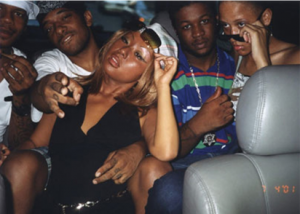 Nikki. S Lee’s Part (14) (2002) depicts an attractive Asian woman in dark makeup and smart attire sat in the back of a car. She has, what appears to be, a man’s arm around her. Due to her staring/arguably sombre expression and unapparent identity of the owner of this arm, my first thoughts are that this presence is an ominous one. Especially as he is sat so far from her despite lack of seatbelt. The name suggests that this is a part of a series, perhaps a story or film stills.
Nikki. S Lee’s Part (14) (2002) depicts an attractive Asian woman in dark makeup and smart attire sat in the back of a car. She has, what appears to be, a man’s arm around her. Due to her staring/arguably sombre expression and unapparent identity of the owner of this arm, my first thoughts are that this presence is an ominous one. Especially as he is sat so far from her despite lack of seatbelt. The name suggests that this is a part of a series, perhaps a story or film stills.
Nikki is an artist that echoes some behaviours of Cindy Sherman, adopting different personalities and identities to create her photographs. However, unlike Cindy Sherman, she investigates different social groups within her work by spending a certain amount of time with them, completely changing her appearance every time, Photographs of her and members of the group are consequently taken, an example being the HipHop Project (2001).
So, for her ‘Parts’ project, she used a collection of photos of her boyfriend and herself, and physically cropped him out of every one. By doing so, she isolates herself and forces attention of the spectator onto details such as her body language. They’re therefore forced to look for more information, so despite the absence of his identity , the subject of this body of work becomes the story of the relationship. However, because of her practice, it makes me question the validity of her emotions. Is this all set up? Is she forcing a narrative into the picture? The fact that most of her facial expressions display some sort of emotional conflict suggest this, in my opinion, people tend to pose with a smile when they know a picture is being taken.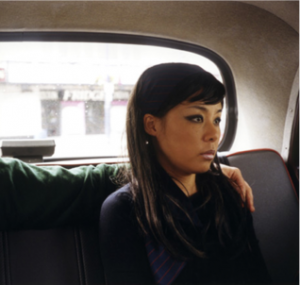
Brittany Carpenter for National Museum of Women in the Arts. (2013). Fluid Identities: The “Parts” and “Projects” of Nikki Lee. [online] Available at: https://nmwa.org/blog/2013/11/01/fluid-identities-the-parts-and-projects-of-nikki-lee/ [Accessed 24 Oct. 2017].
Task 2
Brian O’Doherty (Also known as Patrick Ireland), is an Irish, art critic and writer born in 1928. His book Inside the White Cube: The Ideology of the Gallery Space is a collection of essays that appeared in Artforum Magazine in 1976, with those three issues being almost impossible to obtain, this book is highly commended in the art world. This expanded edition features ‘The Gallery as a Gesture’, a critically acclaimed piece written 10 years after the rest. Curators and other art writers considered his Inside the White Cube ‘one of the most influential and oft-quoted statements of it’s time’ (N. Fox, 2010). His poetic criticism and in-depth analysis of 20th century art is still very much relevant today. With dry wit and educated curiosity, O’Doherty explores the crisis of Post-war and he relationship between the social, economical and aesthetic factors that held an importance over modern art in a gallery setting. In my honest opinion, I bit off a lot more than I could chew with this book as I struggled to understand the authors expansive vocabulary, this subsequently led me to looks up certain terminologies mentioned. Thus, learning a great deal of terminology, useful for writing about art and its theories, especially in a gallery context.
O’Doherty B. (2010) Inside the White Cube. Berkeley: University of California Press, p 12.
Task 2
Jean-Michel Basquiat Dipinti
The book I chose to ‘consume’ is on the works of Jean Michel Basquiat by Gianni Mercurio and Mirella Panepinto. The book outlines Basquiat’s back round briefly and gives us a commentary on why his works gained so much popularity being an outsider of the art world and a black man in 1970s America. In one chapter the book brings up a discriminating idea of why he rose to fame by those who were not fond of his art. They argued that Basquiat had mostly been highlighted for the very fact that he is different in all the convenient ways for the sake of diversity as it says “several American critics sustained, with a certain amount of intellectual hostility, that he had taken advantage of being different”. The book isn’t particularly biased to any side weather it was his art or his back round but narrates it in a factual way. That one quotation from the book accurately reflects on the period in which Basquiat flourished which contrasted to a stereotypical life of an African American citizen as he was one of the earliest of his ethnicity to reach globalised fame as an artist. However, the book talks about the art itself in relation to the artists mind which delves into the fact that the works itself are different rather than the artist. As his paintings are very childish in style but somewhat communicative in a grown up instinctive way. The book emphasises the diversity of his works and talks about its influence from music, urban culture and graffiti rather than on the artists own diversity.
Jean-Michel Basquiat Dipinti by Gianni Mercurio and Mirella Panepinto
Quote from Page 19
Emily-Jayne Ponting: Fine Art: Research and Communication Skills (Task 11)
When summarising my blog I would say that the process of development has helped me define my mode of practise in a lot more depth. I have also become aware that I do not have to produce an oil piece from every photograph I take for it to become art. But that I am actually quite fond of photography and my images alone are strong enough to represent my practise. I am happy where my work is at right now and I believe this blog has only emphasised that for me as an artist.
I found ‘Task 7’ quite challenging for me and I think this was purely down to the use of strong vocabulary; however I enjoy a good challenge. In comparison I feel that ‘Task 9’ got me thinking about why I have such a raw passion for my study and this is always important.

